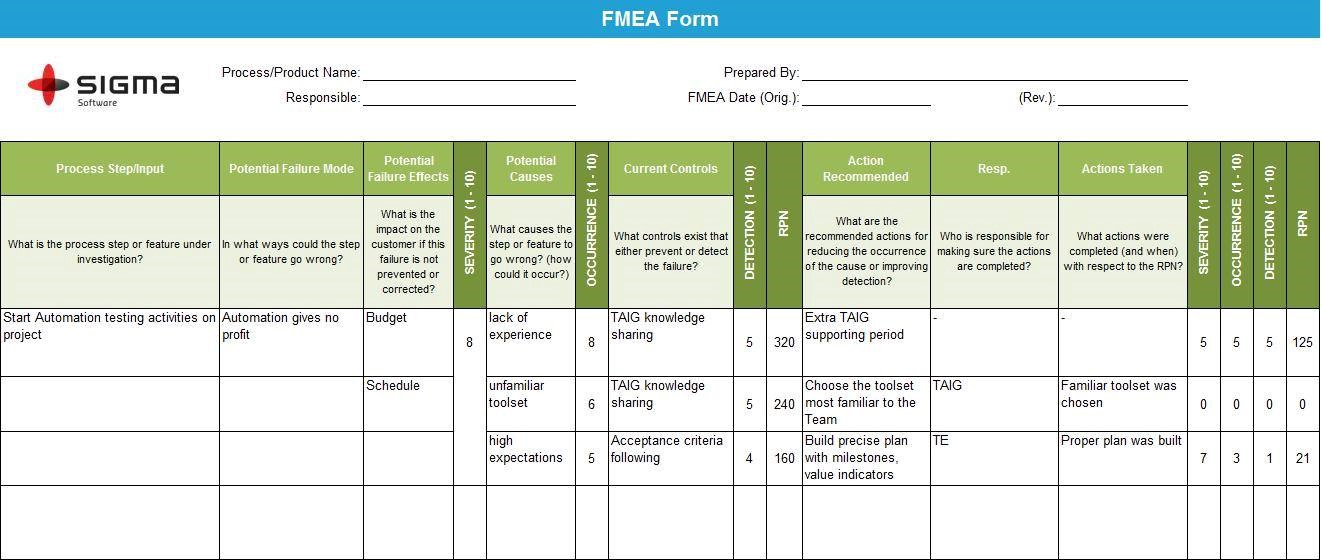
USA
Thank you for reaching out to Sigma Software!
Please fill the form below. Our team will contact you shortly.
Sigma Software has offices in multiple locations in Europe, Northern America, Asia, and Latin America.

USA

Sweden

Germany

Canada

Israel

Singapore

UAE

Australia

Austria

Ukraine

Poland

Argentina

Brazil

Bulgaria

Colombia

Czech Republic

Hungary

Mexico

Portugal

Romania

Uzbekistan
This is the final and the most interesting for me part where I would like to talk about techniques of continuous improvement. This concept implies well-managed systems of control, management and motivation. It is impossible to improve without solving problems. The entity that does not develop becomes noncompetitive and vanishes. I hope that this article will give at least a slight push to your ideas of self-improvement.
Studying all possible negative scenarios at the stage of planning is the main weapon in our arsenal. First, we solve the problem at a much lower cost than it could be at a later stage. Second, we grow professionally. What’s more, we understand the working processes much better. Let’s examine the scheme as an example of root cause.
Areas of application: moderately complex and complex problems

Process step: Just like before, the first step is to identify the problem.
Potential Failure Mode: Identify potential problems which could arise on the way.
Potential Failure Effects: What impact could potential problems make?
Severity: Estimate the «severity» of the problem according to a 10-point scale.
Potential Causes: Draw the root cause(s) for each failure (using RCA to identify them).
Occurrence: Estimate the occurrence according to a 10-point scale, where 10 is the most probable.
Current Controls: Existing measures to prevent the problem from occurring.
Detection: Estimate the level of detection with existing measures according to a 10-point scale, where 10 is the lowest. That is, 10 points will mean that existing measures are totally unable to deal with the problem.
RPN: Risk Priority Number, calculated by multiplying the three scores, Severity, Occurrence and Detection, RPN = Severity x Occurrence x Detection.
Action Recommended: Points to decrease Occurrence level or increase Detection level.
Responsible: who is responsible for the implementation.
Actions Taken
Actions Taken do not complete the process yet. Each action goes through the same estimation stage for Risk Priority Number until the problem is considered resolved.
The main task is to break down the problem to the potential points of priority fault. (RPN). The fault with the highest RPN is the target. The whole process is divided into ten basic steps but works as a cycle:

Kaizen is more of philosophy than of a technique. It claims that any process can be perfected. It is based on the idea of continuous improvement; therefore, the number of ways to implement it is limitless. According to Kaizen, each employee is responsible for finding gaps in the system, and each employee, regardless of the position and level of involvement, offers ways of perfecting the system.
Kaizen is aimed at performance, efficiency and elimination of waste. Waste can be of several types:
| Form of waste | Examples |
|---|---|
| Movement |
|
| Time |
|
| Defects |
|
| Over-processing |
|
| Variations |
|
I suggest using Kaizen system in the following way:
I started by saying that Kaizen is a philosophy rather than a tool. That is why there are so many ways of its application. For example, you can align your personal growth with Kaizen:
Kaizen Self Audit Checklist
To summarize the above, I would like to emphasize that the purpose of this article is not to set rules, but to show the variety of options at the path of problem solving. Every mistake made carries all information necessary for that, you just need to learn how to distinguish it. I hope this text will give, even small, but momentum to your self-improvement ideas.
| Category | № | Description | Check | |
| yes | no | |||
| Motivation | 1 | Can I motivate myself? | ||
| 2 | Can I set goals by myself and achieve them? | |||
| 3 | Do I manage my time well? | |||
| 4 | Do I often try to escape responsibility? | |||
| Communication | 5 | Do I express my ideas and points of view clearly?; | ||
| 6 | Do I listen to other people’s opinion? | |||
| 7 | Is it easy for my colleagues to work with me? | |||
| 8 | Do my soft skills help me to solve issues easily? | |||
| Growth | 9 | Do I allow time for my professional growth? | ||
| 10 | Does my current project allow me to grow? | |||
| 11 | Have there been positive changes in me as a specialist over the past month? | |||
| 12 | Do I have a plan for growth for the near future? | |||
| Work process | 13 | Do I provide proper quality control on the project? | ||
| 14 | Do I keep within estimates? | |||
| 15 | Do I keep statistics / analyze my work? | |||
| 16 | Do I contribute new ideas / influence the project perfection? | |||
| Areas to perfect: | Score (=total ‘yes’/16) | |||

Vlad has been engaged in software development since 2009. Over the years, he had a chance to get a deep understanding of the process and related problems. Today Vlad works a Test Engineer and is responsible for improving the software development process, preventing defects, and spotting errors in functioning of the product.


A Software Bill of Materials (SBOM) is becoming one of the most important documents in modern software development. Still, many organizations struggle to create...

As cloud sovereignty becomes a strategic priority across the EU, Sigma Software applies its deep expertise and extensive experience to contribute to the develop...

Data is everywhere, yet its payoff isn't always there. Many IT leaders struggle with scattered analytics, rising storage costs, and unclear returns.We face...
Would you like to view the site in German?
Switch to German